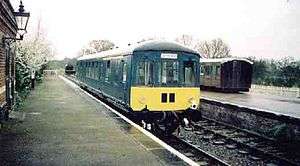British Rail Class 100
| British Rail Class 100 | |
|---|---|
|
Class 100, no. 56301 at County School Station on the Mid-Norfolk Railway on 17 December 2001. This unit was the first heritage DMU vehicle to enter preservation. | |
| In service | 1957–1988 |
| Manufacturer | Gloucester Railway Carriage and Wagon Company |
| Constructed | 1957–1958 |
| Number built | 40 sets (80 cars) |
| Number preserved | 4 cars |
| Formation | 2 cars sets: DMBS-DTCL |
| Capacity |
DMBS: 52 second class seats, DMCL: 12 first and 54 second class seats |
| Operator(s) | British Rail |
| Specifications | |
| Car length | 57 ft 6 in (17.53 m) |
| Width | 9 ft 3 in (2.82 m) |
| Height | 12 ft 8 1⁄2 in (3.87 m) |
| Maximum speed | 70 mph (113 km/h) |
| Weight |
DMBS: 30 long tons 5 cwt (67,700 lb or 30,700 kg), DMCL: 24 tons 15 cwt (55,400 lb or 25,100 kg) |
| Prime mover(s) | Two BUT 6-cylinder diesel engines |
| Power output | 150 bhp (112 kW) per engine |
| Transmission | Mechanical: 4-speed epicyclic gearbox |
| Braking system(s) | Vacuum |
| Coupling system | Screw-link couplings, British Standard gangways |
| Multiple working | ■ Blue Square |
| Track gauge | 4 ft 8 1⁄2 in (1,435 mm) |
The British Rail Class 100 diesel multiple units were built by Gloucester Railway Carriage and Wagon Company Limited from 1956 to 1958, designed and built in collaboration with the Transport Sales Dept. of T.I. (Group Services) Ltd.
Introduction
The class were designed to be lightweight to allow for good acceleration. None were selected for refurbishment and withdrawals started in 1969. The last passenger car was withdrawn from service in 1988.
| Lot No. | Car type | Quantity | Fleet numbers | Notes |
|---|---|---|---|---|
| 30278 | Driving Motor Brake Second (DMBS) | 20 | 50339–50358 | |
| 30279 | Driving Trailer Composite with Lavatory (DTCL) | 20 | 56094–56113 | originally Class 143. |
| 30444 | Driving Motor Brake Second (DMBS) | 20 | 51108–51127 | |
| 30445 | Driving Trailer Composite with Lavatory (DTCL) | 20 | 56300–56319 | originally Class 143. |
Under initial classification 1973, the DTCs became 143s, but were later reclassified as 100s.
56111 was used as a training aid by the Ministry of Defence until 1985. Two sets entered departmental service: 51122 and 56300 became ADB975664 and ADB975637 for use as the "Stourton Saloon" – the Eastern Region General Manager's saloon – for which the class gained a small amount of "fame"; these were scrapped in 1990. The other pair were ADB975349 and ADB975539 (ex 51116 and 56101) and were used as the Eastern Region inspection saloon, until being scrapped in 1993. 56106 survived the longest time on the national network, being scrapped in 2000.
Preservation
Trailer car 56301 was the first diesel multiple unit car to enter preservation in 1969, originally being used at the Chasewater Railway.
The Class has not fared well in preservation. 7 cars entered preservation of which only 4 now exist. 50341 and 56099 were preserved by the West Somerset Railway, but were scrapped & dismantled in 1991. The National Railway Museum had intended to preserve 53355 (ex 50355), but a lack of space prevented this car, and the Class 105 coupled to it from being moved to York and they were vandalised beyond repair at Crewe.
| Number | Vehicle type | Location |
|---|---|---|
| 51118 | DMBS | Midland Railway - Butterley |
| 56097 | DTCL | Midland Railway - Butterley |
| 56301 | DTCL | Mid-Norfolk Railway, County School Station |
| 56317 | DTCL | Private site.[1] |
References
- Golding, Brian. A Pictorial Record of British Railways Diesel Multiple Units.
- Haresnape, Brian. British Rail Fleet Survey 8: Diesel Multiple Units – The First Generation.
- Marsden, Colin J. Motive Power Recognition: 3 DMUs.
- Robertson, Kevin. British Railway Pictorial: First Generation DMUs.
